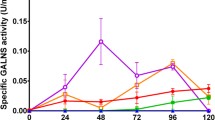Abstract
Studies using lysosomal membrane vesicles have suggested that efflux of the sulfate that results from lysosomal glycosaminoglycan degradation is carrier-mediated. In this study, glycosaminoglycan degradation and sulfate efflux were examined using cultured skin fibroblasts and lysosomes deficient in the lysosomal enzymeN-acetylgalactosamine-4-sulfatase. Such fibroblasts store dermatan sulfate lysosomally, which could be labelled biosynthetically with Na 352 SO4. The addition of recombinantN-acetylgalactosamine-4-sulfatase to the media of35S labelled fibroblasts degraded up to 82% of the stored dermatan [35S] sulfate over a subsequent 96 h chase and released inorganic [35S] sulfate into the medium. In the presence of 4-acetamido-4′-isothiocyanatostilbene-2,2′-disulfonic acid (SITS), sulfate was reused to a minor extent in newly synthesized proteoglycan. Isolated granules from recombinant enzyme supplemented fibroblasts degraded stored dermatan [35S]sulfate to sulfate which was rapidly released into the medium at a rate that was reduced by the extra-lysosomal presence of the lysosomal sulfate transport inhibitors SITS, Na2SO4 and Na2MoO4. SITS also inhibited dermatan sulfate turnover, although it had no effect on the action of purified recombinant enzymein vitro. These data imply that sulfate clearance occurred concomitantly with dermatan sulfate turnover in the lysosome even at high substrate loading, and that lysosome-derived sulfate, while available, is reutilized minimally in synthetic pathways.
Similar content being viewed by others
Abbreviations
- SITS:
-
4-acetamido-4′-isothiocyanatostilbene-2,-2′-disulfonic acid
- GAG:
-
glycosaminoglycan
- 4S:
-
N-acetylgalactosamine-4-sulfatase
- r4S:
-
recombinant humanN-acetylgalactosamine-4-sulfatase
- PBS:
-
phosphate buffered saline
- BME:
-
basal modified Eagle's medium
- FBS:
-
fetal bovine serum
- GalNAc4S-GlcA-GalitolNAc4S:
-
β-(N-acetyl-d-galactosamine-4-sulfate)-(1–4)-β-d-glucuronic acid)-(1–3)-N-acetyl-d-[1-3H]galactosaminitol-4-sulfate
- DS:
-
dermatan sulfate
- MPS:
-
mucopolysaccharidosis
References
Freeman C, Hopwood JJ (1992) inHeparin and Related Polysaccharides (Lane D, Lindahl U, eds), pp 191–228. London: Edward Arnold.
Bame K, Rome LH (1985)J Biol Chem 260:11293–9.
Forster S, Lloyd JB (1988)Biochim Biophs Acta 947:465–91.
Rome LH, Hill DF, Bame KJ, Crain LR (1983)J Biol Chem 258:3006–11.
Tietze K, Kohn AD, Kohn LD, Bernardini I, Andersson HC, Adamson MD, Harper GS, Gahl WA (1989)J Biol Chem 264:4762–65.
Pisoni RL, Flickinger KS, Thoene JG, Christensen HN (1987)J Biol Chem 262:6010–17.
Pisoni RL, Thoene JG, Christensen HN (1985)J Biol Chem 260:4791–98.
Mancini GM, de Jong HR, Galjaard H, Verheijen FW (1989)J Biol Chem 264:15247–54.
Bernar J, Tietze F, Kohn LD, Bernardini I, Harper GS, Grollman EF, Gahl WA (1986)J Biol Chem 261:17107–12.
Tietze F, Seppala R, Renlund M, Hopwood JJ, Harper GS, Thomas GH, Gahl WA (1989)J Biol Chem 264:15316–22.
Jonas AJ, Speller RJ, Conrad PB, Dubinsky WP (1989)J Biol Chem 264:4953–56.
Lloyd JB (1979)Biochem J 115:703–7.
Docherty K, Brenchley GV, Hales CN (1979)Biochem J 178:361–6.
Jonas AJ, Jobe H (1990)J Biol Chem 265:17545–9.
Pisoni RL (1991)J Biol Chem 266:979–85.
Gahl WA, Bashan N, Tietze F. Bernardini I, Schulman JD (1982)Science 217:1263–5.
Rome LH, Hill DF (1986)Biochem J 235:707–13.
Rome LH, Crain LR (1981)J Biol Chem 256:10763–8.
McKusick VA, Neufeld EF (1983) inMetabolic Basis of Inherited Disease, 5th Edn (Stanbury JB, Wyngaarden JB, Fredrickson DS, Goldstein JL, Brown MS, eds), pp 751–77. New York: McGraw-Hill.
Cöster L, Carlstedt T, Malmström A, Särnstrang B (1984)Biochem J 220:575–82.
Anson DS, Taylor JA, Bielicki J, Harper GS, Peters C, Gibson GJ, Hopwood JJ (1992)Biochem J 284:789–94.
Hopwood JJ, Muller V, Harrison JR, Carey WF, Elliott H, Robertson EF, Pollard AC (1982)Med J Aust I:257–60.
Taylor JA, Gibson GJ, Brooks DA, Hopwood JJ (1990)Biochem J 268:379–86.
Brooks DA, McCourt PAG, Gibson GJ, Ashton LJ, Shutter M, Hopwood JJ (1991)Am J Human Genet 48:710–19.
Yanagishita M, Hascall VC (1984)J Biol Chem 259:10260–9.
Wasteson A (1971)J Chromatogr 59:87–97.
Keller JM, Keller KM (1987)Biochim Biophs Acta 926:139–44.
King BM, Rozaklis T, Hopwood JJ, Harper GS (1992)Biochem Med Metab Biol 47:260–4.
Singh H, Derwas N, Poulos A (1987)Arch Biochem Biophys 259:382–90.
Buckmaster MJ, Ferris AL, Storrie B (1988)Biochem J 249:931–23.
Smith PK, Krohn RI, Hermanson GT, Mallia A, Gartner FH, Provenzano MD, Fujimoto EK, Goeke NM, Olson BJ, Klenk DC (1985)Anal Biochem 150:76–85.
Brown, RE, Jarvis KL, Hyland KH (1989)Anal Biochem 180:136–39.
Gibson GJ, Saccone GTP, Brooks DA, Clements PR, Hopwood JJ (1987)Biochem J 248:755–64.
Hopwood JJ, Elliott H, Muller VJ, Saccone GTP (1986)Biochem J 234:507–14.
Blumenkrantz N, Asboe-Hanson G (1973)Anal Biochem 54:484–89.
Harper GS, Hascall VC, Yanagishita M, Gahl WA (1987)J Biol Chem 262:5637–43.
Hopwood JJ (1979)Carbohydr Res 69:203–16.
Maroteaux P, Leveque B, Marie J, Lamy M (1962)Presse Méd 71:1849.
Hopwood JJ, Elliott H (1985)Biochem J 229:579–86.
Holtzman E (1989)Lysosomes, pp 270–271. New York: Plenum
Elgavish A, Meezan E (1988)Biochem Biophys Res Commun 152:99–106.
Schneider DL (1983)J Biol Chem 258:1833–8.
Boyd CAR, Shennan DB (1986)J Physiol 379:367–76.
Stankiewicz PJ, Gresser MJ (1988)Biochemistry 27:206–12.
Author information
Authors and Affiliations
Rights and permissions
About this article
Cite this article
Harper, G.S., Rozaklis, T., Bielicki, J. et al. Lysosomal sulfate efflux following glycosaminoglycan degradation: measurements in enzyme-supplemented Maroteaux-Lamy syndrome fibroblasts and isolated lysosomes. Glycoconjugate J 10, 407–415 (1993). https://doi.org/10.1007/BF00731045
Received:
Revised:
Issue Date:
DOI: https://doi.org/10.1007/BF00731045




